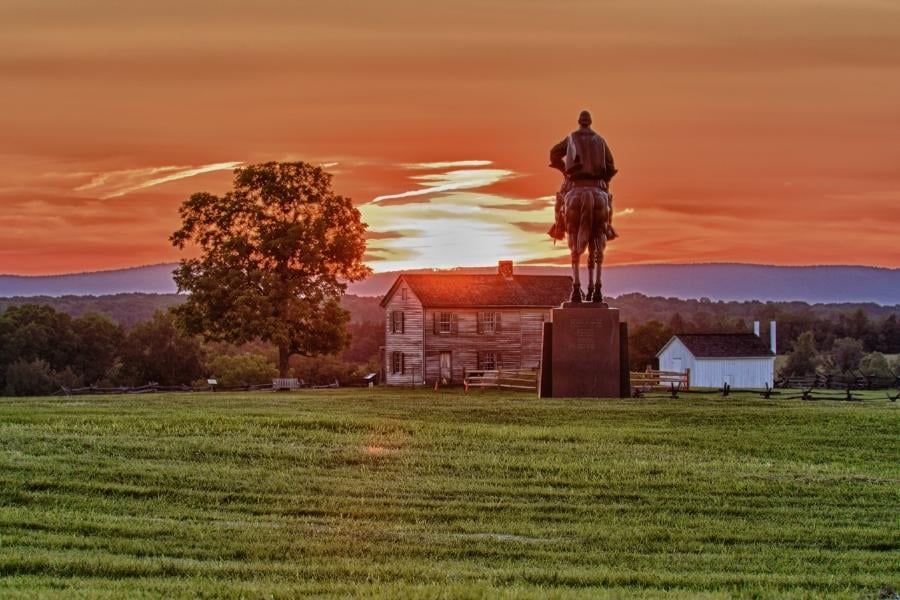Take a Tour of 6 Civil War Sites in Virginia
If you’re a history buff living in Virginia, you’re in luck!
Whether it's a quick jaunt to a battlefield in Manassas or a series of weekend road trips tracking Civil War campaigns across Virginia, take a look at these don't-miss destinations.
 1) Manassas
1) Manassas
Battlefield Names:
Location: Manassas National Battlefield Park Virginia
Importance of This Site
The First Battle of Bull Run (First Manassas) took place on July 21, 1861, near Manassas, Virginia, early in the American Civil War. It was the first major land battle of the war and was a victory for the Confederates. The Union forces, under Brigadier General Irvin McDowell, were initially victorious but were eventually driven back by Confederates led by General Thomas "Stonewall" Jackson.
The Second Battle of Bull Run (Second Manassas) occurred August 28 to August 30, 1862. Confederate General Robert E. Lee defeated Union Major General John Pope's Army of Virginia. Lee's victory forced Pope to retreat to Washington, DC, setting the stage for Lee's first invasion of the North during the Maryland Campaign.
Must See
- The Stonewall Jackson monument. At this site, Confederate Brig. Gen. Bee exclaimed: “There stands Jackson like a stone wall!” which gave Confederate Lt. Gen. Jackson the moniker “Stonewall Jackson.”
- The infamous spot where the Confederate troops, low on ammunition, resorted to throwing rocks at the Union battle line.
 Manassas Battlefield and Stonewall Jackson monument - photo from Canva
Manassas Battlefield and Stonewall Jackson monument - photo from Canva
2) Fredericksburg
Battlefield Name: Battle of Fredericksburg
Location: Fredericksburg & Spotsylvania National Military Park
Importance of This Site
The Battle of Fredericksburg, fought on December 11-15, 1862, was a significant Confederate victory.
Union Major General Ambrose Burnside launched attacks against Confederate General Robert E. Lee's well-entrenched Army of Northern Virginia. Despite heavy casualties, particularly during the infamous raid on Marye's Heights, the Union forces were unable to break through the Confederate defenses.
The battle ended with Burnside withdrawing his battered army across the Rappahannock River, a costly and demoralizing defeat for the Union.
Must See
A hilltop parcel called Marye's Heights. From this high point in the city, the Confederates had a clear advantage. The sloping terrain and imposing stone wall of the bastion made it extremely difficult for the Union troops to invade.
 Chatham Terrace - photo from nps.gov
Chatham Terrace - photo from nps.gov
3) Chancellorsville
Battlefield Name: The Battle at Chancellorsville
Location: Fredericksburg & Spotsylvania National Military Park
Importance of This Site
The Battle of Chancellorsville, fought from April 30 to May 6, 1863, was a Confederate victory. It marked General Robert E. Lee's bold decision to divide his outnumbered forces and execute a risky flanking maneuver against Union General Joseph Hooker's Army of the Potomac.
Despite the Confederate victory, they lost General Stonewall Jackson, a trusted and skilled commander, which significantly impacted the future dynamics of Lee's army.
Must See
The monument denoting the spot where Confederate Lt. Gen. “Stonewall” Jackson took a fatal shot by friendly fire.
4) Battle of the Wilderness
Battlefield Name: Battle of the Wilderness
Location: Fredericksburg & Spotsylvania National Military Park
Importance of This Site
The Battle of the Wilderness, fought May 5-7, 1864, was a pivotal engagement during the Civil War. It marked the beginning of Union General Ulysses S. Grant's Overland Campaign against Confederate General Robert E. Lee in Virginia.
The battle is known for its dense forest terrain that negated the Union's numerical advantage and favored the entrenched Confederate defenders. Despite many casualties (on both sides), Grant demonstrated his tenacity and set the stage for a relentless series of battles that ultimately led to the Confederacy's defeat.
Must See
A museum display with the riveting quote, “Lee to the rear!” Sensing the onslaught, Rebel troops from Texas convinced Confederate leader General Robert E. Lee to pursue the enemy from the rear rather than from the front lines.
5) Siege of Petersburg
Battlefield Name: Siege of Petersburg
Location: Petersburg National Military Park
Importance of This Site
The Siege of Petersburg, from June 1864 to April 1865, was a crucial campaign during the war. Union forces under General Ulysses S. Grant attempted to cut off Petersburg, Virginia, which was a vital supply line to the Confederate capital of Richmond.
The siege dragged on for nearly ten months, resulting in trench warfare similar to what would occur in World War I. It eventually forced the Confederates to evacuate both Petersburg and Richmond, leading to the collapse of the Confederate government and the end of the war.
Must See
The Crater. In the opening scene of the Jude Law movie Cold Mountain, there’s an earthshaking moment when Union troops tunnel under a Confederate line and set off explosives. Restoration efforts here include an outline of the crater from the blast and the tunnel access point.
 Poplar Grove - Photo from Canva
Poplar Grove - Photo from Canva
6) Appomattox Courthouse
Battlefield Name: Appomattox Courthouse
Location: Appomattox Courthouse National Military Park
Importance of This Site
Appomattox Court House is the site where Confederate General Robert E. Lee surrendered to Union General Ulysses S. Grant on April 9, 1865, effectively ending the American Civil War. The surrender marked a symbolic moment of reconciliation and the beginning of national reunification after years of conflict.
Must See
The site of Lee’s surrender, the McLean house.
 The McLean House - Photo from Canva
The McLean House - Photo from Canva
Some tips as you visit Civil War sites around Virginia:
- With proper ID, ask for free admission or a military discount.
- The title “courthouse” doesn’t have to be a building for city government. As Civil War history displays explains, it can be a specific crossroads or a meeting point.
- Remember, private displays and state parks can interpret history from a pointed perspective. The National Park Service attempts to detail Civil War history objectively.
A road trip to a battlefield may not be everyone’s first choice for a family weekend getaway, but learning the names and reading the stories makes it a worthwhile excursion. And for those stationed in Virginia, the path is easy.
For more day trips and travel ideas, download our free Military Family Travel guide below!





